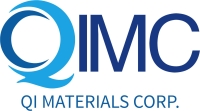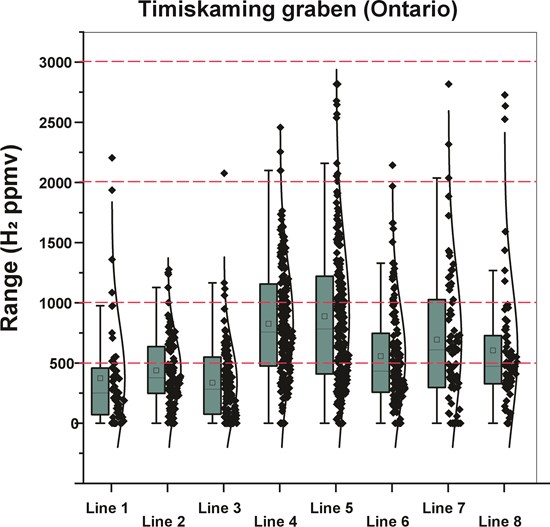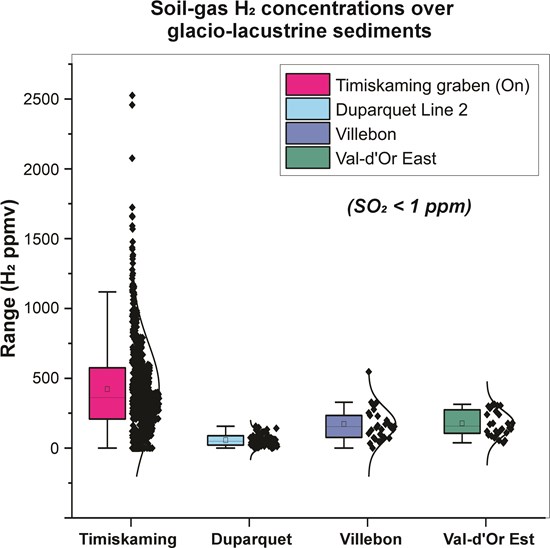QIMC and DMED Confirm Major Expansion of Hydrogen Zone by over 11 Kilometers in Ontario's Temiscamingue Graben
454 Samples Analyzed - 55% Above 500 ppm, 19 Samples Over 2,000 ppm, and a high of 2,817 ppm Hydrogen (H2)
October 27, 2025 7:00 AM EDT | Source: Quebec Innovative Materials Corp.
Montreal, Quebec--(Newsfile Corp. - October 27, 2025) - Québec Innovative Materials Corp. (CSE: QIMC) (OTCQB: QIMCF) (FSE: 7FJ) is pleased to announce that new soil-gas survey results from the Ontario section of the Témiscamingue Graben have confirmed a major northward extension of the natural hydrogen system by more than 11 kilometers.
A total of 454 soil-gas samples were collected and analyzed across lines 5-8. Results show 251 samples exceeding 500 ppm hydrogen (H₂), including 116 above 1,000 ppm, 19 above 2,000 ppm, and a peak concentration of 2,817 ppm. The data clearly demonstrate that hydrogen concentrations intensify toward the north, confirming a vast, structurally controlled degassing system within the Ontario portion of the Témiscamingue Graben.
"These results mark another major milestone for QIMC in the Ontario-Quebec hydrogen corridor," said John Karagiannidis, President & CEO of QIMC. "We've confirmed that the hydrogen-bearing corridor extends more than 11 kilometers northward, with more than half of all samples exceeding 500 ppm and 19 surpassing 2,000 ppm—including a high of 2,817 ppm. This confirms a continuous, fault-controlled hydrogen system on a regional scale and reinforces Ontario's strategic role within the emerging Ontario–Quebec hydrogen corridor."
The survey, conducted in collaboration with the Institut National de la Recherche Scientifique (INRS) under the supervision of Prof. Marc Richer-Laflèche, continues to expand the scale and continuity of this fault-controlled hydrogen corridor.
"As part of our commitment to sustainable regional development, we are also advancing discussions with the Témiscamingue First Nation on establishing an AI data infrastructure project powered by off-grid natural hydrogen energy," said John Karagiannidis, President & CEO of QIMC. "This initiative aims to position the Ontario–Quebec Hydrogen Corridor as both a clean energy hub and a next-generation data resource center, enabling Indigenous and local communities to participate directly in the digital and energy economies of the future."
In the second phase of fieldwork conducted across the municipalities of Couttsville, Thwaites, and Belle-Vallée (Ontario), the INRS-QIMC team completed four new Soil-Gas survey lines totaling 45.3 km and 454 stations. These additional surveys, located north of Lines 1 to 4, were designed to confirm the high hydrogen concentrations observed to the south, particularly along Line 4.
The statistical distribution of the data measured along Lines 5 to 8 was compared with that of Lines 1 to 4 (Fig. 1). The presence of strong hydrogen concentrations was confirmed on Line 5. Overall, hydrogen (H₂) concentrations are generally higher along Lines 6 to 8 than in the southern portion of the survey area (Lines 1 and 2). This demonstrates a clear north–south variability in the natural hydrogen potential within the Ontario segment of the Témiscamingue Graben system. The distance separating Lines 4 and 5 is 1.6 km, and the survey area covering Lines 1 to 8 extends over 11.3 km along the north–south axis and 23 km east–west—representing an area of approximately 260 km².
Figure 1. Statistical compilation of Soil-Gas hydrogen data measured along Lines 1 to 8 within the geochemical survey area of July 2025 (Témiscamingue Graben, Ontario).
To view an enhanced version of this graphic, please visit:
https://images.newsfilecorp.com/files/7968/271974_558beabab4dd1914_001full.jpg
"The distribution of data, with a large number (47) hydrogen concentrations exceeding 1,500 ppm, is a clear indication of the hydrogen-rich nature of the soils in the Témiscamingue valley. These new results confirm what had already been demonstrated in 2024 for the Quebec section of the graben, particularly around St-Bruno-de-Guigues (QIMC)," notes Professor Marc Richer-Laflèche. "To date, scientific literature does not report any comparable geological context showing both such high hydrogen concentrations and such a large areal distribution," observes Professor Richer-Laflèche. For the Témiscamingue Graben valley, this suggests a geological environment combining several essential elements for natural hydrogen generation:
Iron-rich sources (iron formations, peridotites, basalts, Nippissing dykes);
Optimal water supply (Ottawa River watershed); and
Proterozoic tectonic structures reactivated during the Paleozoic and Cenozoic eras, allowing water to descend at depth and hydrogen to migrate upward into reservoirs (limestone and dolomitic rocks) or surface-reaching fractures.
It is important to emphasize that the Quaternary geological setting of the Témiscamingue valley, in both Ontario and Quebec, is dominated by a thick layer of fine-grained glaciolacustrine sediments. This layer may explain some of the hydrogen distribution characteristics observed in the valley, particularly the lateral spread of high hydrogen concentrations across broad areas.
Conceptually, the presence of groundwater and fine-grained Quaternary silty-clay sediments could favor the horizontal dispersion of hydrogen; however, the elevated concentrations suggest the substrate itself may be a hydrogen source. To verify this, new Soil-Gas data were compiled from three Abitibi regions (Duparquet, East Val-d'Or – airport sector, and Lake Villebon east of Val-d'Or) where volcanic and sedimentary rocks are also overlain by thick fine-grained glaciolacustrine sediments.
The comparison (Fig. 2) highlights the difference between hydrogen concentrations in the Témiscamingue Graben valley and those in the Abitibi sectors. The Abitibi sites show median hydrogen values of 50 to 125 ppm, whereas the Témiscamingue valley shows a median of 375 ppm, with numerous anomalous values above 1,000 ppm—levels not observed in Abitibi soils.
Consequently, the data available to date suggest that glaciolacustrine sediments are not the cause of the hydrogen enrichment observed in the Témiscamingue Graben valley. This conclusion is further supported by the near absence of measurable methane (CH₄ detected in fewer than 3% of samples) and moderate CO₂ concentrations (average 0.6%) in samples collected along Lines 1 to 8. These results minimize the role of potential fermentation of organic matter within the sediments.
Figure 2. Statistical compilation of Soil-Gas hydrogen data measured in the Ontario section of the Témiscamingue Graben and along profiles conducted in the Duparquet, Villebon, and East Val-d'Or regions. The data shown in this diagram are filtered to include only samples containing less than 1 ppm of SO₂.
To view an enhanced version of this graphic, please visit:
https://images.newsfilecorp.com/files/7968/271974_558beabab4dd1914_002full.jpg
The data presented in Figure 2 originate from an INRS research project funded by FRQNT and part of the PhD thesis work of Antoine Cuckovic (INRS).
"As part of our commitment to sustainable regional development, we are also advancing discussions with the Témiscamingue First Nation on establishing an AI data infrastructure project powered by off-grid natural hydrogen energy," said John Karagiannidis, President & CEO of QIMC. "This initiative aims to position the Ontario–Quebec Hydrogen Corridor as both a clean energy hub and a next-generation data resource center, enabling Indigenous and local communities to participate directly in the digital and energy economies of the future."
Investor Relations Engagement
The Company announces entry into an agreement related to marketing and investor relations. On Oct 24, 2025, the Company entered into a media services contract (the "NIA Agreement") with GRA Enterprises LLC, DBA National Inflation Association ("NIA"). Pursuant to the terms of the NIA Agreement, NIA will, among other items, provide the Company with marketing services, which includes social media management, content creation, distribution, digital marketing, and any other marketing services as agreed upon by the Company and NIA (the "NIAServices"). The NIA Agreement has a term of six (6) months and is anticipated to commence on or about October 27, 2025. The Company will make total payment to NIA of US$50,000, as consideration for the Services.
NIA, based in Mooresville, North Carolina, has a strong track record of investor communications for publicly traded companies. The Company will not issue any securities to NIA as compensation. NIA and its principals are at arm's length to the Company and do not have any interest, direct or indirect, in the Company or its securities nor do they have any right to acquire such an interest.
For more information about NIA: Contact ga@gerardadams.com or visit them at 112 Camp Lane, Mooresville, North Carolina, 28117.
About DiagnaMed Holdings Corp. (DMED)
DiagnaMed Holdings Corp. (CSE: DMED) (OTCQB: DGNMF) is a Canadian technology company that delivers innovative solutions for the clean tech and life sciences industries. Visit DiagnaMed.com.
About Québec Innovative Materials Corp. (QIMC)
Quebec Innovative Materials Corp. (CSE: QIMC) (OTCQB: QIMCF) (FSE: 7FJ) is a mineral exploration and development company dedicated to exploring and harnessing the potential of North America's abundant resources. With properties in Ontario, Quebec, Nova Scotia and Minnesota (US), QIMC is focused on specializing in the exploration of white (natural) hydrogen and high-grade silica deposits. QIMC is committed to sustainable practices and innovation. With a focus on environmental stewardship and cutting-edge extraction technology, we aim to unlock the full potential of these materials to drive forward clean energy solutions to power the AI and carbon-neutral economy and contribute to a more sustainable future.
For more information please contact:
QUÉBEC INNOVATIVE MATERIALS CORP.
John Karagiannidis
President & CEO
Email: info@qimaterials.com
Tel: +1 514-726-7058
Neither the Canadian Securities Exchange nor its Regulation Services Provider (as that term is defined in the CSE policies) accepts responsibility for the adequacy or accuracy of this news release and has neither approved nor disapproved the contents of this news release.
Forward-Looking Statements
This news release contains statements that constitute "forward-looking statements". Such forward-looking statements involve known and unknown risks, uncertainties and other factors that may cause Québec Innovative Materials' actual results, performance or achievements, or developments in the industry to differ materially from the anticipated results, performance or achievements expressed or implied by such forward-looking statements. Forward-looking statements are statements that are not historical facts and are generally, but not always, identified by the words "expects," "plans," "anticipates," "believes," "intends," "estimates," "projects," "potential" and similar expressions, or that events or conditions "will," "would," "may," "could" or "should" occur.
Although Québec Innovative Materials believes the forward-looking information contained in this news release is reasonable based on information available on the date hereof, by their nature, forward-looking statements involve assumptions, known and unknown risks, uncertainties and other factors which may cause our actual results, performance or achievements, or other future events, to be materially different from any future results, performance or achievements expressed or implied by such forward-looking statements.
Examples of such assumptions, risks and uncertainties include, without limitation, assumptions, risks and uncertainties associated with general economic conditions in Canada and abroad; adverse industry events; future legislative and regulatory developments in the natural resources sector, in particular as regards the regulation of white (natural) hydrogen exploration, development and exploitation; the Company's ability to access sufficient capital from internal and external sources, and/or inability to access sufficient capital on favorable terms; natural resources industry and markets in Canada and generally; the ability of Québec Innovative Materials to implement its business strategies; competition; and other assumptions, risks and uncertainties.
The forward-looking information contained in this news release represents the expectations of the Company as of the date of this news release and, accordingly, is subject to change after such date. Readers should not place undue importance on forward-looking information and should not rely upon this information as of any other date. While the Company may elect to, it does not undertake to update this information at any particular time except as required in accordance with applicable laws.
Cautionary Statements This news release contains "forward-looking information" and "forward-looking statements" within the meaning of applicable Canadian securities legislation. These statements are based on expectations, estimates, and projections as of the date of this release. Forward-looking statements involve risks and uncertainties, which may cause actual results to differ materially from current expectations. Readers are cautioned not to place undue reliance on these statements, as no assurance can be provided regarding future outcomes.

To view the source version of this press release, please visit https://www.newsfilecorp.com/release/271974



